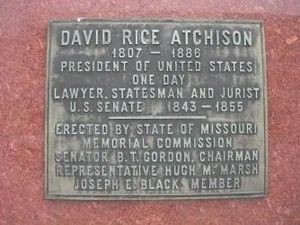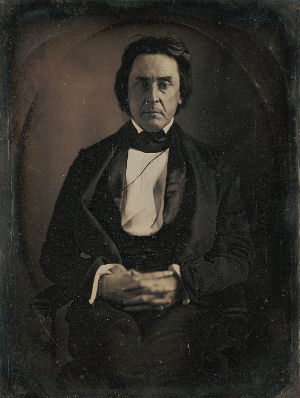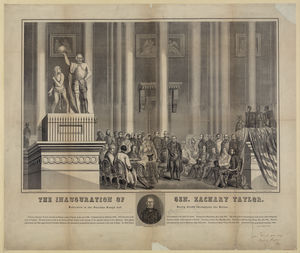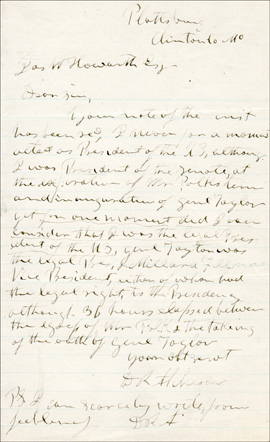
A plaque affixed to a statue in Plattsburg, Missouri, reads, "David Rice Atchison, 1807–1886, President of United States One Day." The day of Atchison’s presumed presidency was March 4, 1849. Who was David Rice Atchison and on what basis could he claim to have been the president of the United States, even if for only one day?
David Rice Atchison was a Missouri Democrat who served in the U.S. Senate from 1843 to 1855. Raised and educated in Kentucky, he settled in Missouri and opened a law practice in Clay County in 1829. Atchison rose to prominence in Missouri when he served as legal counsel to members of Joseph Smith’s Church of Jesus Christ of Latter-day Saints, popularly known as the Mormons, who were being forcibly removed from Jackson County in 1833. Mormons living in his district helped to give Atchison his start in politics when they supported his successful candidacy for the state legislature in 1834. Atchison later served as brigadier general in the state militia and sought to maintain order as anti-Mormon violence ultimately drove them from the state. He went on to serve as a state court judge for two years before the governor appointed him to fill a vacant seat in the Senate in 1843.1

Unfortunately, Atchison’s support for Mormon rights did not extend to civil and human rights for others. In the Senate he was a staunch defender of slavery. He was a member of the so-called F Street Mess, a group of southern senators who successfully pushed for the repeal of the Missouri Compromise and passage of the 1854 Kansas-Nebraska Act, which allowed for the expansion of the institution into new western states and sparked outrage among opponents of slavery. Atchison joined other pro-slavery advocates and organized incursions into Kansas in 1854 to ensure that Kansas would become a slave state. He warned Senator Jefferson Davis of Mississippi that they would “be compelled to shoot, burn, and hang” to drive the “Abolitionists” out of Kansas. A group of pro-slavery settlers named their town Atchison in his honor, and the violence that engulfed Kansas marked another milestone on the road to civil war.2
Atchison’s actions in Kansas had lasting consequences, but today he is best remembered for the role he played—or didn’t play—in the presidential transition in 1849. Atchison was popular with his Senate colleagues, and they elected him president pro tempore on 13 separate occasions. In those days, the vice president regularly presided over Senate sessions, and the Senate chose a president pro tempore to preside in his place only during brief vice-presidential absences. On March 2, 1849, Vice President George M. Dallas took leave of the Senate for the remainder of the session and the Senate elected Atchison as president pro tempore.
Atchison’s position as president pro tempore combined with a fluke of the political calendar in 1849 to set the stage for his alleged one-day presidency.
Until the adoption of the Twentieth Amendment in 1933, presidential and congressional terms began and ended at noon on March 4. In 1849 March 4 fell on a Sunday. On the morning of March 4, President James Polk signed the last of the session’s legislation at the White House and at 6:30 a.m. recorded in his diary, “Thus closed my official term as President.” The Senate, having been in session all night, adjourned sine die at 7:00 a.m. President-elect Zachary Taylor, in observance of the Christian Sabbath, preferred not to conduct his inauguration on Sunday, March 4, and the ceremony was delayed until the next day. On Monday, March 5, Taylor took the oath of office on the Capitol’s east front portico and the transition of power was complete.3

But if President Polk’s term ended on March 4 at noon, and Zachary Taylor was not sworn in until noon on March 5, who was president on March 4? Under the Presidential Succession Act of 1792 the Senate president pro tempore immediately followed the vice president in the line of presidential succession. Had Atchison been president from noon on March 4 to noon on March 5?
Neither the Congressional Globe nor the Senate Journal included any suggestion that there was a vacancy in the presidency prior to Taylor’s inauguration on the 5th, yet the notion that Atchison had briefly ascended to the office of president of the United States began to circulate. The earliest public statement came in the March 12 edition of the Alexandria Gazette, which reported that Atchison “was on Sunday, by virtue of his office, President of the United States—for one day!” The “fact” was eventually included in profiles of Atchison, including his entry in an early version of the Biographical Directory of the American Congress. In 1907 a Philadelphia newspaper published a story about Atchison’s one-day presidency, which sparked further discussion in newspapers around the country. As often happens with a story like this, it became more elaborate with each retelling. “It was held by Congress,” the account stated, “that the functions of the President must devolve upon him from Sunday noon till Monday noon.” Atchison allegedly took the role so seriously, the story went, that he “signed one or two official papers as President.” Supposedly Atchison’s Democratic colleagues had playfully suggested that he could summon the army and prevent Taylor, a member of the rival Whig Party, from assuming the presidency altogether.4
Is there any truth to the idea that Atchison was the chief executive for a day? No. Atchison himself did not take the idea seriously. He wrote in 1880 that “I never for a moment acted as President of the U.S.” Congress did not make any determinations about who was president on March 4, and Atchison certainly did not sign official paperwork, but he did have some fun with it. He later joked that because of the long nights in session the previous days, he might have slept through his “term” except that his friends woke him to congratulate him and seek patronage jobs for their friends. “I recollect,” he said in 1889, “that Senator Mangum of North Carolina suggested that I make him secretary of state.” He liked to say that his presidency had been “the honestest administration this country ever had.”5

In 1925 historian George Haynes—an authority on the Senate—dismissed the claims of Atchison’s presidency. The clearest indication that Atchison was not president, he noted, was the fact that Atchison’s existing term as senator and, more importantly, as president pro tempore, had ended at noon on March 4. The position of president pro tempore was, in fact, vacant. Atchison was not elected to the position again until the Senate’s special session convened at noon on March 5. Minutes later the president and vice president took their oaths.6
If Atchison was not the president on March 4, who was? Atchison himself believed that the office was essentially vacant for that day. He could point to precedent on this point. Inauguration day similarly had fallen on a Sunday in 1821, the day on which President James Monroe was to take the oath for a second term. Monroe also chose to delay his oath until March 5, leading John Quincy Adams to write in his diary that the delay created “a sort of interregnum during which there was no qualified person to act as President.” Constitutional scholar Charles Warren concluded in 1925, however, that the Constitution only requires that the president take the oath “before he enter upon the execution of his office.” Zachary Taylor, Warren argued, was for all intents and purposes president the moment Polk’s term ended, since he could have taken the oath and executed his responsibilities at any time thereafter.7
Despite debunking by scholars, the myth of Atchison’s one-day presidency carried on, as evidenced by the plaque below his bronze statue unveiled in Plattsburg, Missouri, in 1928. Months later the Atchison “presidency” was highlighted in the widely syndicated “Ripley’s Believe It or Not” newspaper feature, and it has resurfaced periodically ever since.8
Regardless of whether the presidency fell to the Senate’s president pro tempore or the country actually lacked a president for a day in 1849, the next time inauguration day fell on a Sunday, the president-elect took steps to avoid the same confusion. On Saturday, March 3, 1877, two days before his public inaugural ceremony, Rutherford B. Hayes took the oath of office in a private ceremony at the White House to become the 19th president of the United States. Hayes’s oath raises another question, however, that has not attracted much attention. If outgoing president Ulysses S. Grant’s term did not end until March 4, did the United States have two presidents at the same time for one day?9
Notes
5. Atchison to Joseph Howarth, [c. 1880], Shapell Manuscript Foundation, accessed October 9, 2020, https://www.shapell.org/manuscript/david-rice-atchison-polk-fillmore-taylor-president-for-five-minutes/#transcripts; Walter B. Stevens, “A Day and Night with Old Davy: David R. Atchison,” Missouri Historical Review 31, no. 2 (January 1937): 129, 130–31.
7. "John Quincy Adams diary 31, 1 January 1819–20 March 1821, 10 November 1824–6 December 1824, page 545" [electronic edition], The Diaries of John Quincy Adams: A Digital Collection, Massachusetts Historical Society, 2004, accessed October 7, 2020, http://www.masshist.org/jqadiaries/php/doc?id=jqad31_545; Haynes, “President of the United States for a Single Day,” 310.